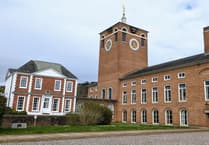Tom Hendy, of Modbury, writes:
I am a lifelong resident of the parish of Modbury, my family having been here for many generations.
I have been in business in Modbury for most of my working life, having owned and run a garage for 14 years, and thence farming, my wife’s family having produced clotted cream here for 47 years.
We are now involved in share farming over 800 acres, and milking 500 cows. We employ local people, born and bred in the town.
I am writing to put my views on record as regards the joint local plan and its impact on Modbury and its future.
It is crucial that we get this right, rather than pander to the interests of just a few people.
In the case of the proposed site behind Long Park, this would benefit one large construction company with no long-term care or responsibility for the community. Thus personal gain and a hunger for profit could become the driving force that destroys the character of our unique town.
To destroy the future for so many to provide personal gain for so few should never be allowed to happen. These things cannot be undone.
This situation is made even more ridiculous because there is an obvious solution that has the exact reverse effect.
There have been 15 plots of land put forward by landowners as potential sites. Many of these could have a variety of developments on them, ranging in size and character to suit the individual sites, thus enhancing the diversity of the town, while satisfying the alleged need for more housing.
Indeed, the number of new houses imposed is in itself suspect as it would appear to unfairly burden Modbury with far more houses than other communities to the west. Sharing the numbers more evenly would reduce the impact on Modbury and its infrastructure. It only seems fair to share the load.
Many of the smaller sites proposed have been dismissed as having ‘significant constraints’. This is absolute nonsense in the case of many of them, as the constraint would only be significant if all 100 houses were to be sited there. The sites have been offered up as being suitable for a proportion of the required number, not the lot. It appears that the ‘significant constraints’ are being raised to bamboozle us into thinking there is only one possibility. This is tantamount to deception.
Indeed, there are small developments that have successfully been there for years, such as Wakehams Close and Oakwood Drive. These prove the viability and sustainability of such sites.
There are many benefits in using smaller and varied sites, to list but a few:
* The visual impact is dramatically diluted, with the plans for each site able to be tailored to the individual site.
* As each site would stand alone, the benefits of employment would fall on smaller local builders and merchants.
* One large corporate developer may be seen to have too much ‘clout’ over the planners, a suspicion enhanced by the way the numbers originally proposed are inevitably increased as the work progresses, irrespective of local opinion.
* The problems relating to access and other traffic issues would not be as relevant as the volume would be much reduced due to the smaller developments.
* As individual sites could be developed one at a time, the overall growth would keep pace with demand rather than having to import people to fulfil the availability. Why build houses until they are needed?
* As above, the impact on the infrastructure, the health centre, the school, the sewage works, could be assessed as the sites evolved, instead of finding out that they are all overstretched when the developers have long disappeared in a cloud of dust.
I haven’t mentioned the many negative points regarding the extension of RA1 as I feel every argument for smaller sites can be applied against one large site.
The meeting at Modbury Memorial Hall on July 27 was most overwhelmingly against the site behind Long Park.
One wonders why these meetings are called if the feeling of all who care enough to attend are ignored.




Comments
This article has no comments yet. Be the first to leave a comment.